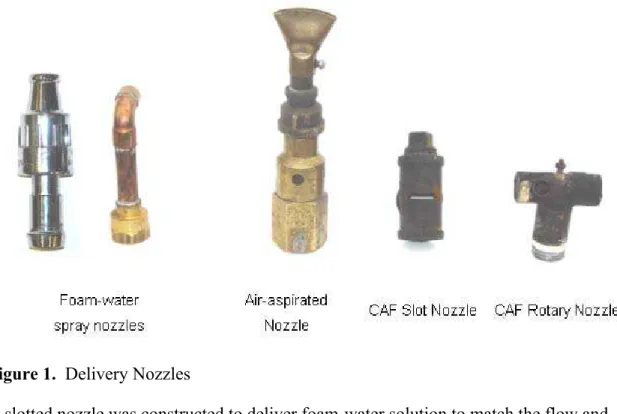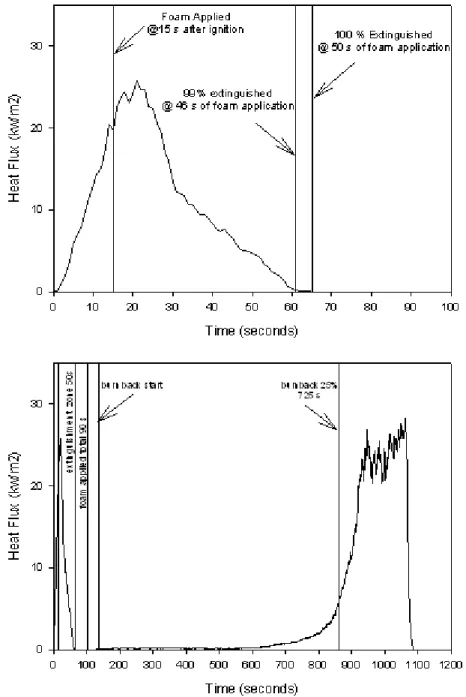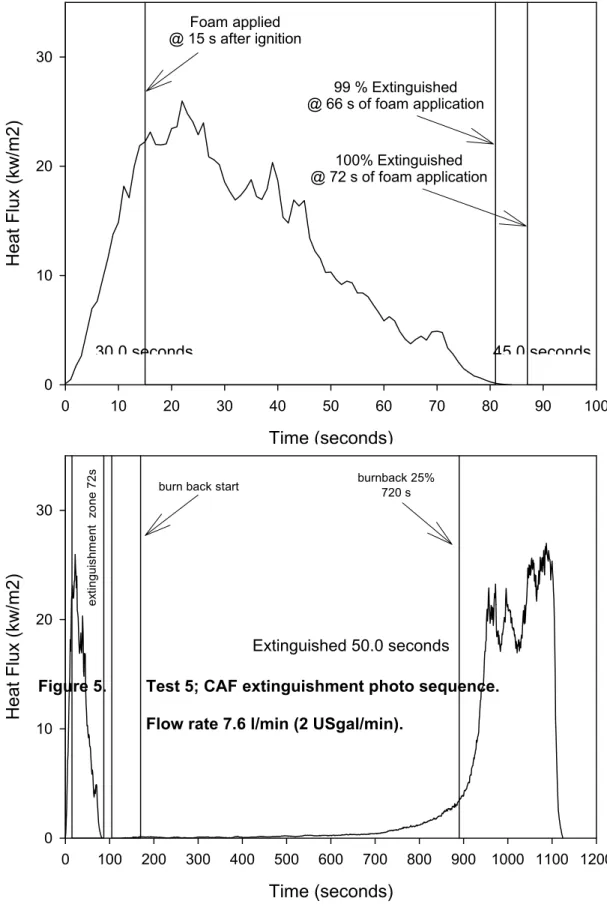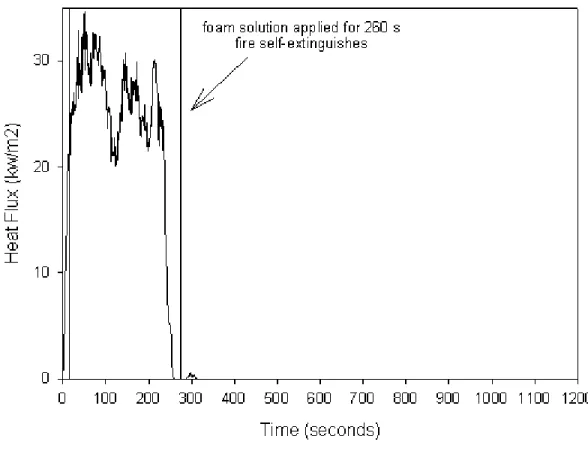Publisher’s version / Version de l'éditeur:
Vous avez des questions? Nous pouvons vous aider. Pour communiquer directement avec un auteur, consultez la
première page de la revue dans laquelle son article a été publié afin de trouver ses coordonnées. Si vous n’arrivez pas à les repérer, communiquez avec nous à PublicationsArchive-ArchivesPublications@nrc-cnrc.gc.ca.
Questions? Contact the NRC Publications Archive team at
PublicationsArchive-ArchivesPublications@nrc-cnrc.gc.ca. If you wish to email the authors directly, please see the first page of the publication for their contact information.
https://publications-cnrc.canada.ca/fra/droits
L’accès à ce site Web et l’utilisation de son contenu sont assujettis aux conditions présentées dans le site LISEZ CES CONDITIONS ATTENTIVEMENT AVANT D’UTILISER CE SITE WEB.
8th Fire Suppression and Detection Research Application Symposium [Proceedings], pp. 1-11, 2004-01-01
READ THESE TERMS AND CONDITIONS CAREFULLY BEFORE USING THIS WEBSITE.
https://nrc-publications.canada.ca/eng/copyright
NRC Publications Archive Record / Notice des Archives des publications du CNRC : https://nrc-publications.canada.ca/eng/view/object/?id=09422b07-f357-4156-9cc9-45b487dee1da https://publications-cnrc.canada.ca/fra/voir/objet/?id=09422b07-f357-4156-9cc9-45b487dee1da
NRC Publications Archive
Archives des publications du CNRC
This publication could be one of several versions: author’s original, accepted manuscript or the publisher’s version. / La version de cette publication peut être l’une des suivantes : la version prépublication de l’auteur, la version acceptée du manuscrit ou la version de l’éditeur.
Access and use of this website and the material on it are subject to the Terms and Conditions set forth at
The Comparison of CAF with air aspirated and unexpanded foam water solutions
The Comparison of CAF with air aspirated and unexpanded foam water solution
Crampton, G.; Kim, A.
NRCC-46969
A version of this document is published in / Une version de ce document se trouve dans:
8th Fire Suppression and Detection Research Application Symposium, Orlando, Florida, Jan. 21-23, 2004, pp. 1-11
The Comparison of CAF with Air Aspirated and Unexpanded Foam Water Solution
Presented at the 8th Fire Suppression and Detection Research Application Symposium, Orlando, FL, January 2004
by
George Crampton and Andrew Kim
INTRODUCTION
Air aspirated foam is created close to or in the nozzle by entraining air with a water jet and impacting on one or more obstacles. Some of the energy of the stream is used to agitate the mixture and foam is produced. “Foam-water” refers to a foam solution of water and foam concentrate that has not been expanded by air.
Compressed-air foam (CAF) has been proven to be an effective fire suppression material for both Class A and B fires, however, the effectiveness of CAF compared to
aspirated systems and foam water systems has not yet been quantified. While
air-aspirated foam systems have been around for many years the development of high quality Aqueous Film-Forming Foam (AFFF) concentrates have allowed foam systems with little or no air expansion to be used in controlling large flammable liquid fuel fires. To
effectively compare these systems a series of 22 full scale fire tests were conducted with CAF, air-aspirated foam and foam water solution using 4.64 m2 pool fire.
This paper describes a series of 22 full scale Class B fire tests designed to compare CAF, air-aspirated, and foam water solution in extinguishing a 4.64 m2 pool fire in accordance with the CAN/ULC-S560-98 Standard for Category 3 Aqueous Film-Forming Foam (AFFF) Liquid Concentrates [1]. In addition to visual observations, radiant heat flux was also measured at a point 1.83 m from the edge of the fuel pan and 1.5 m off the ground.
DESCRIPTION OF TESTS
The tests were conducted indoors at the Fire Risk Management Program’s National Fire Laboratory where the burn hall measures 55 m long by 30 m wide by 12 m high. The 4.64 m2 test pan measured 2.43 m in diameter with a wall thickness of 6 mm and a wall height of 125 mm. The fuel was floated on 5 mm of water to ensure complete coverage of the pan. Each test used 80 litres of heptane with the exception of Tests 16 to 19, where regular winter formula gasoline was used for comparison. Heptane fuel was chosen due to its consistent nature and for comparison with the previous testing performed by NRC under the UL 162 Standard for Foam Equipment and Liquid Concentrates.
Extinguishment data was taken using a 2 w/cm2 heat flux meter and Solartron data acquisition system.
All the foam systems delivered the same solution flow rate of 7.6 litres per min. The solution was premixed in a cylinder that was pressurised to between 80 and 100 psi. This was necessary to achieve the exact flow rate for each apparatus.
The CAF produced in this series of tests was delivered through a slotted nozzle
constructed to match the flow and distribution pattern of the standard air-aspirated nozzle (Figure 1). Test 15 was the only exception using a CAF Rotary Nozzle instead of the slotted nozzle. The CAF had measured expansion ratios ranging from 10.0:1 to 11.9: 1. The air-aspirated foam was produced using the 7.6 litre/ min nozzle described in the standard complete with the spreader attachment (Figure 1). The air-aspirated system produced measured expansion ratios of 4.7:1 to 10.1:1 (as described in CAN/ULC-S560-98 Standard for Category 3 Aqueous Film-Forming Foam (AFFF) Liquid Concentrates, UL 162 Standard for Foam Equipment and Liquid Concentrates [2] and in NFPA Standard No. 412 [3]).
Figure 1. Delivery Nozzles
A slotted nozzle was constructed to deliver foam-water solution to match the flow and distribution pattern of the CAF and air-aspirated nozzles (Figure 1). There was no expansion of the foam solution with this system. It was necessary for the flow rate in Test 13 to be increased from 7.6 litres per minute (Test 10) to 22.7 litres per minute in order to extinguish the fire. To accomplish this, a fire hose nozzle was selected and adjusted to deliver a solid cone spray that enabled all of the foam solution to be delivered inside the pan without greatly changing the dynamics of the delivered pattern.
Tests 20, 21 and 22 had reduced CAF flow rates to determine how low a density could be applied and still extinguish the fire.
The details of the test set-up and instruments used as well as the test procedures are described in IRC Research Report #147 [4].
TEST RESULTS Heptane Fire Tests
Tests 1 to 15 and 20 through 22 were conducted using 80 litres of Commercial Grade N-Heptane Lot 2/13/03. The results are listed in Table 1.
4
Table 1. CAF Comparison Test Results
Test # Foam Class A or B
Fuel 80 litres
15s preburn Nozzle type
Flow
l/min Type Concentration Expansion
drain time 25%; min:s
1 CAF A * heptane slot 7.54 Silvex 0.60% 10.5:1 9:30 na 2:45 9:50 extra foam added 2 CAF A heptane slot 7.54 Silvex 0.60% 10.0:1 9:06 1:17 1:38 6:10 extra foam added
3 CAF A heptane slot 7.56 Silvex 0.60% 10.5:1 10:05 1:02 1:30 6:02
4 Air Asp. A heptane standard test 7.2 Silvex 0.60% 3.07:1 1:32 none none na
5 CAF B heptane slot 7.55 National 3.00% 11.7 :1 5:02 0:46 0:50 12:05
6 Air Asp. B heptane standard test 7.2 National 3.00% 10:01 2:56 1:06 1:12 12:00 7 no expansion B heptane course spray 7.5 National 3.00% none none none none na
8 Air Asp. B heptane standard test 7.2 National 1.50% 8.6:1 1:50 1:58 2:59 10:12 extra foam added
9 CAF B heptane slot 7.55 National 1.50% 12.2:1 3:30 na 1:22 8:10
10 no expansion B heptane slot 7.4 National 3.00% none none none none na
11 CAF B heptane slot 7.5 National 1.50% 11.75:1 3:58 1:04 1:15 9:23
12 CAF B heptane slot 7.5 National 2.00% 12:1 4:15 0:46 0.55 10:15
13 no expansion B heptane fire hose 22.7 National 3.00% 1.7:1 none 1:57 2:06 6:30 extra foam added 14 Air Asp. B heptane standard test 7.2 National 2.00% 8.4:1 1:50 1:04 1:32 9:48
15 CAF B heptane rotary 7.5 National 3.00% 11:01 4:30 0:40 0:44 15:10
16 CAF B gasoline slot 7.5 National 3.00% 12:01 4:20 1:00 1:06 4:16
17 Air Asp. B gasoline standard test 7.2 National 3.00% 10:01 3:00 1:44 2:43 3:56 extra foam added 18 CAF B gasoline slot 7.5 Wormald
mil spec 3.00% 10:01 5:00 0:50 1:00 5:48
19 Air Asp. B gasoline standard test 7.2 Wormald
mil spec 3.00% 4.7:1 3:30 0:57 3:39 9:02 extra foam added
20 CAF B heptane slot 3.1 National 3.00% 11:01 4:10 none none
---21 CAF B heptane slot 3.6 National 3.00% 11:01 4:00 none none
---22 CAF B heptane slot 5.6 National 3.00% 11.9:1 3:50 0:53 1:30 15:40
* 30 second preburn
Test Description Foam Description
Burn Back Time; min:s Extinguishment time;
min:s 99% 100%
Tests 1, 2, 3 and 4 were conducted using 0.60% Class A (Silvex) foam solution. Test 1 had a 30 second pre-burn while all other tests had the required 15 second pre-burn. The extinguishment time for test 1 was 2 minutes and 45 seconds due primarily to the hotter pan wall from the longer pre-burn. Tests 2 and 3 showed that CAF using class A foam can effectively extinguish the heptane fire in 90 seconds and provide over 6 minutes of burn-back protection. The air-aspirated system, in test 4, made poor quality Class A foam and could not extinguish the fire with 5 minutes of application.
Tests 5 to 15 and 20 through 22 were conducted using National Aerolite Class B AFFF foam solution. National Aerolite foam is a non-military specification foam that is
generally used at 3% concentration. It is approved for use with standard sprinklers under the UL162 Standard for Foam Equipment and Liquid Concentrates.
Test 5 used CAF at 3% concentration and extinguished the fire in 50 seconds with a burn back time of 12 minutes and 5 seconds. The heat flux data for test 5 is shown in Figure 4. Test 6 used air-aspirated foam (good quality 10:1 expansion with 3 minute drain time) and extinguished the fire in 1 minute 12 seconds with a burn-back time of 12 minutes. The heat flux data for Test 6 is shown in Figure 5. Tests 7 and 10 used foam-water solution only, with no expansion, and could not extinguish the fire with over 4 minutes of application. The heat flux data for test 10 is shown in Figure 6.
To study how the system would perform under poor quality foam solution, tests were conducted at 1/2 strength foam concentration. CAF Tests 9 and 11 used a 1.5% Class B solution and extinguished the fire in 1 minute 22 seconds and 1 minute 15 seconds, respectively. Burn-back times were 8:10 and 9:23. Test 8 used the air-aspirated system with 1.5% solution (good quality 8.6:1 expansion with 1min:50s drain time) and the fire was extinguished in 3 minutes. The burn back time was 10 minutes and 12 seconds but twice as much foam had been delivered to the pan (3 min instead of 90 seconds).
Figure 4. Test 5; CAF heat flux data using National Aerolite Foam @ 3%.
Flow rate 7.6 l/min (2 USgal/min).
7 Time (seconds) 0 10 20 30 40 50 60 70 80 90 100 Heat Flux (kw /m 2 ) 0 10 20 30 Foam applied @ 15 s after ignition 100% Extinguished @ 72 s of foam application 99 % Extinguished @ 66 s of foam application Time (seconds) 0 100 200 300 400 500 600 700 800 900 1000 1100 1200 Heat Flux (kw /m 2 ) 0 10 20 30
burn back start burnback 25%720 s
ex ti n guis h m e nt zo ne 72 s Extinguished 50.0 seconds 45 0 seconds 30 0 seconds
Figure 5. Test 5; CAF extinguishment photo sequence. Flow rate 7.6 l/min (2 USgal/min).
Figure 5. Test 6; Air-aspirated heat flux data using National Aerolite Foam @ 3%. Flow rate 7.6 l/min (2 USgal/min).
Figure 6. Test 10; Unexpanded foam solution heat flux data using National Aerolite Foam @ 3%. Flow rate 7.6 l /min ( 2 USgal/min).
Tests 12 and 14 were conducted at 2 % concentration. Test 12 used CAF at 2% and extinguished the fire in 55 seconds with a burn-back time of 10 minutes 15 seconds. Test 14 used air-aspirated foam at 2% concentration and extinguished the fire in 1 minute 32 seconds with a burn-back time of 9 minutes 48 seconds.
Test 15 was conducted using 3% CAF at the 7.6 l/min flow rate. The difference in this test was that the slot nozzle was replaced with NRC’s patented CAF rotary nozzle. This test had the fastest knock down and extinguishment time of all the tests. It had a 99% extinguishment time of 40 seconds and 100% in 44 seconds. The burn-back was
15 minutes and 10 seconds. The rotary nozzle had the ability to cover a large area of fire with a gentle application so the fuel surface was not agitated by the delivered foam.
Tests 20, 21, and 22 were CAF tests (slotted nozzle) conducted at reduced flow rates to determine the minimum application rate required to extinguish the fire. Test 20 and 21 used 3% solution at a flow rate of 3.1 l/min and 3.6 l/min, respectively. Neither of these tests could extinguish the fire. Test 22 used 3% solution at a flow rate of 5.6 l/min ( ¾ of the standard flow) and did extinguish the fire in 1 minute 30 seconds with a burn-back time of 15 minutes 40 seconds.
Gasoline Fire Tests
Tests 16 through 19 were conducted using regular winter grade gasoline instead of heptane. The CAN/ULC-S560 standard calls for aviation gasoline grade 80 and UL162 calls for heptane. It was decided to use regular gasoline since aviation gas was not readily available and winter grade gas has a high vapour pressure for performance at low temperatures.
Test 16 used CAF at 3% concentration and 7.6 l/min flow rate. The fire was extinguished in 1 minute 6 seconds with a burn-back time of 4 minutes 16 seconds. The gasoline fire was a little more difficult to extinguish than the heptane fire but the largest difference was the burn-back time. The increase in vapour pressure from the gasoline greatly reduced the burn-back time. This was found to be true for all the gasoline tests.
Test 17 used air-aspirated foam at 3% concentration and 7.6 l/min flow rate. The fire was extinguished in 2 minutes 43 seconds with a 3 minute 56 second back. The burn-back was exceptionally poor, considering 1.8 times the allowed amount of foam was used in the test.
Test 18 used a mil-spec foam by Wormald at 3% concentration. This CAF test extinguished the gasoline fire in 60 seconds and had a burn-back of 5 minutes 40 seconds.
Test 19 used air-aspirated 3%, mil-spec foam by Wormald. The foam quality was not very good having an expansion of 4.7:1 and a 25% drain time of 3 minutes 30 seconds. The air-aspirated foam extinguished the fire 99% of the fire in 57 seconds but the
operator had trouble getting the last flames extinguished since the foam kept opening holes in the surface. At 3 minutes 39 seconds the fire was fully extinguished.
CONCLUSIONS
This test series has shown the superior fire extinguishing properties of Compressed-air foam over air-aspirated foam and foam-water spray. This was true for both Class A and B foams on heptane and gasoline fires. CAF also had the ability to extinguish the fire using Class A foam while air-aspirated foam could not. This is due to the fact that the delivered foam is uniform in consistency, has smaller more rugged bubbles, and longer drain times. As the quality of the air-aspirated foam improves, it’s performance
improves, but it only approaches the quality of CAF and as more energy is used to generate the foam, less power is available to the stream for transporting it. Unexpanded AFFF solution alone cannot match the performance of CAF or air-aspirated foam when delivered into the base of the fire. The flow rate had to be increased 3 fold before it could extinguish the fire, showing that the film-forming layer must remain on top of the fuel to be effective. This is difficult when the density of the solution is greater than the fuel. The extinguishment densities for the gasoline tests demonstrated that CAF could
extinguish the fire with at least 60% less material than the air-aspirated foam using class B solution.
Reductions in solution concentrations affect foam quality and performance to a much greater extent in air-aspirated systems than CAF systems. This is a result of the foam being generated in the pipe rather than in the short expansion zone of an air-aspirated nozzle. Even when the concentration was reduced by a third to 2%, the CAF system only suffered a 13% performance reduction while the air-aspirated performance dropped 27%. The reduced flow tests showed that with a 26% reduction in solution flow (5.6 l/min instead of 7.6 l/min) the extinguishment density increased 37%. This performance is still 7% better than air-aspirated foam at the normal flow rate of 7.6 l/min.
This test series demonstrated that CAF out-performs air-aspirated foam and foam water solution when delivered into the base of the fire. Comparison testing using overhead
systems must be performed to study the effects of fire plume dynamics on CAF and conventional foam water sprinkler systems. This will be undertaken in future UL162 fire tests comparing the fire extinguishing performance of foam-water sprinklers to a fixed pipe overhead CAF system.
ACKNOWLEDGEMENTS
The authors wish to thank Michael Ryan and the staff of the Fire Risk Management Program.
REFERENCES
1. CAN/ULC-S560-98 Standard for Category 3 Aqueous Film-Forming Foam (AFFF) Liquid Concentrates.
2. UL 162, Standard for Foam Equipment and Liquid Concentrates
3. NFPA 412 – Standard for Evaluating Aircraft Rescue and Fire Fighting Foam Equipment, National Fire Protection Association, Quincy, MA 1998.
4. Crampton, G. and Kim A., “Comparison of the Fire Suppression Performance of Compressed-Air Foam with Air Aspirated and Unexpanded Foam Water
Solution”, IRC Research Report 147, 2004



